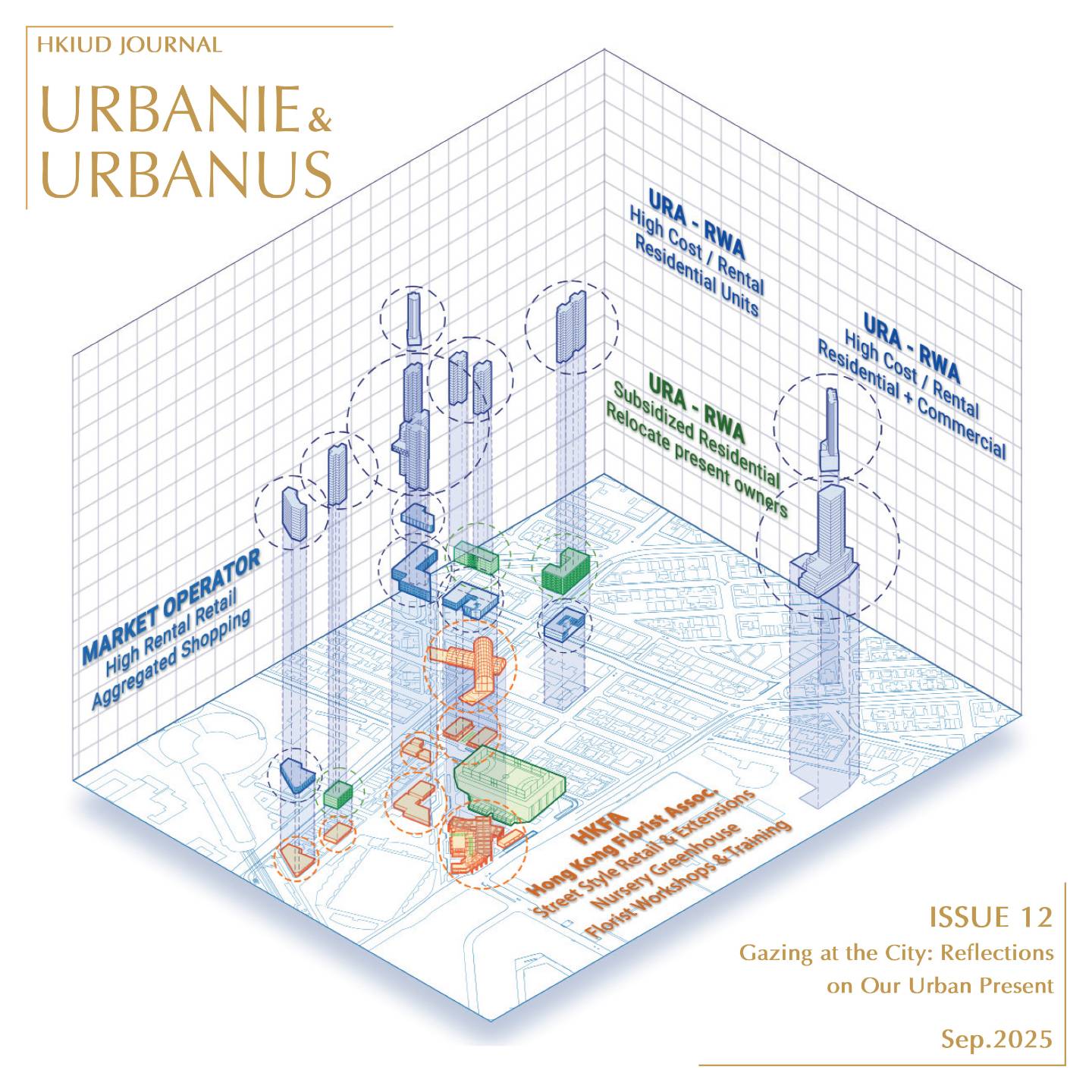Urbanie & Urbanus
Issue 2025 Sep
Gazing at the City: Reflections on Our Urban Present
Issue 12, P. - P.
Gender Sensitivity in Urban Design: Strategies for More Inclusive Pedestrian Spaces in Tseung Kwan O, Hong Kong
References
- Abson, D. J., Dougill, A. J., & Stringer, L. C. (2012). Using Principal Component Analysis for information-rich socio-ecological vulnerability mapping in Southern Africa. Applied Geography (Sevenoaks), 35(1–2), 515–524. https://doi.org/10.1016/j.apgeog.2012.08.004
Arieska, P. K., & Herdiani, N. (2018). Margin of error between simple random sampling and stratified sampling. In PROCEEDING International Conference Technopreneur and Education 2018 (Vol. 1, No. 1).
Bellizzi, M. G., Eboli, L., & Forciniti, C. (2019). Segregation vs interaction in the walkways: An analysis of pedestrians’ perceptions. Research in Transportation Business & Management, 33, 100410-. https://doi.org/10.1016/j.rtbm.2019.100410
Centre for health protection. (2007). Building Healthy Cities: Guidelines for Taking Forward the Healthy City Project in Hong Kong. https://www.chp.gov.hk/files/pdf/building_healthy_cities_guidelines_b5.pdf
Gehl, J. (1971). Life between buildings: using public space. Arkitektens Forlag.
Gender Case: Hong Kong. (n.d.). How is Hong Kong’s progress in addressing spatialised gender inequality? Onebite. https://www.onebitedesign.com/guts-blog/gendercasehk
Grabosky, P. N. (1995). Fear of Crime, and Fear Reduction Strategies. Current Issues in Criminal Justice, 7(1), 7–19. https://doi.org/10.1080/10345329.1995.12036675
Harrouk, C. (2019). What Can Cities Imagined by Women Look Like? The Case of Barcelona. Archdaily. https://www.archdaily.com/927948/how-can-cities-imagined-by-women-look-like-the-case-of-barcelona
Jacobs, J. (2011). The death and life of great American cities (50th anniversary ed., 2011 Modern Library ed.). Modern Library.
Jensen, W. A., Stump, T. K., Brown, B. B., Werner, C. M., & Smith, K. R. (2017). Walkability, complete streets, and gender: Who benefits most? Health & Place, 48, 80–89. https://doi.org/10.1016/j.healthplace.2017.09.007
Kaiser, H. F. (1958). The varimax criterion for analytic rotation in factor analysis. Psychometrika, 23(3), 187–200. https://doi.org/10.1007/BF02289233
Lee, S., Han, M., Rhee, K., & Bae, B. (2021). Identification of Factors Affecting Pedestrian Satisfaction toward Land Use and Street Type. Sustainability, 13(19), 10725. https://doi.org/https://doi.org/10.3390/su131910725
Lee, S., & Kung, S. (n.d.). Tseung Kwan O Healthy City Project Case Study. Health Promotion Administration, Ministry of Health and Welfare. https://www.hpa.gov.tw/File/Attach/923/%E5%81%A5%E5%BA%B7%E5%9F%8E%E5%B8%82%E5%B0%87%E8%BB%8D%E6%BE%B3%E6%A1%88%E4%BE%8B%E4%BB%8B%E7%B4%B9.pdf
Litman, T. A. (2003). Economic Value of Walkability. Transportation Research Record, 1828(1), 3–11. https://doi.org/10.3141/1828-01
Lynch, K. (1964). The image of the city. M.I.T. Press.
Mazzulla, G., Eboli, L., & Forciniti, C. (2024). Do women perceive pedestrian path attractiveness differently from men? Transportation Research. Part A, Policy and Practice, 179, 103890-. https://doi.org/10.1016/j.tra.2023.103890
Mishra, P., Singh, U., Pandey, C. M., Mishra, P., & Pandey, G. (2019). Application of student's t-test, analysis of variance, and covariance. Annals of cardiac anaesthesia, 22(4), 407-411.
Nasreldin, R., & Ibrahim, A. (2024). Toward a framework for the design of fair shared open spaces case study: Effat University, Jeddah. ArchNet-IJAR. https://doi.org/10.1108/ARCH-09-2023-0261
Onebite. (2021). Ming Tak Sports Court | Hong Kong. One Bite Design. https://www.onebitedesign.com/ming-tak-sports-court
Parida, P., & Parida, M. (2009). Appreciation of Gender Differences in Development of Qualitative Level of Service for Sidewalks. Women’s Issues in Transportation: Summary of the 4th International Conference. Volume 2: Technical Papers, 2(46), 246–253. http://www.trb.org/Publications/Blurbs/165294.aspx
Planning department. (n.d.). New Development Areas. https://www.pland.gov.hk/pland_en/publications/NTpamphlets.html
Planning department. (2021). Hong Kong 2030+. https://www.pland.gov.hk/pland_en/p_study/comp_s/hk2030plus/TC/document/2030+_booklet.pdf
Planning department. (2022). Planning for Liveable New Town: Tsuen Kwan O. Tsuen Kwan O. https://www.pland.gov.hk/pland_en/outreach/educational/NTpamphlets/pdf/nt_tko_sc.pdf
Planning department. (2023). Land Utilization in Hong Kong. https://www.pland.gov.hk/pland_en/info_serv/open_data/landu/
Sahani, R., & Bhuyan, P. k. (2020). Modelling Pedestrian Perspectives in Evaluating Satisfaction Levels of Urban Roadway Walking Facilities. Transportation Research Procedia, 48(2352–1465), 2262–2279. https://doi.org/https://doi.org/10.1016/j.trpro.2020.08.289.
Sorenson, S. B., Joshi, M., & Sivitz, E. (2013). Knowing a Sexual Assault Victim or Perpetrator: A Stratified Random Sample of Undergraduates at One University. Journal of Interpersonal Violence, 29(3), 394-416. https://doi.org/10.1177/0886260513505206 (Original work published 2014)
The Government of the Hong Kong Special Administrative Region. (2018). Experience Sharing Cases. Gender Mainstreaming. https://www.hyab.gov.hk/Gender_Mainstreaming/en/exp_sharing_care/
Transport department. (2017). Public Transport Strategy Study. https://www.td.gov.hk/filemanager/tc/publication/ptss_final_report_chi.pdf
United Nations, author, Ait Kaci, Y., & United Nations, author. (2017). The sustainable development goals. United Nations Publications.
Urban Planning Society of China. (2021). Street Design Guide. https://www.planning.org.cn/news/uploads/2021/03/6062c223067b9_1617084963.pdf
Vallejo-Borda, J. A., Cantillo, V., & Rodriguez-Valencia, A. (2020). A perception-based cognitive map of the pedestrian perceived quality of service on urban sidewalks. Transportation Research. Part F, Traffic Psychology and Behaviour, 73, 107–118. https://doi.org/10.1016/j.trf.2020.06.013
Zapata, O., & Honey-Rosés, J. (2022). The Behavioural Response to Increased Pedestrian and Staying Activity in Public Space: A Field Experiment. Environment and Behaviour, 54(1), 36–57. https://doi.org/10.1177/0013916520953147.

